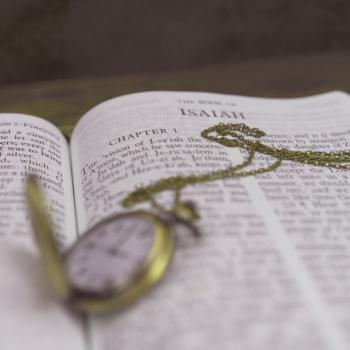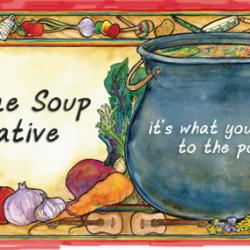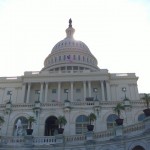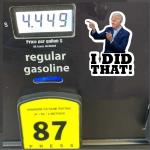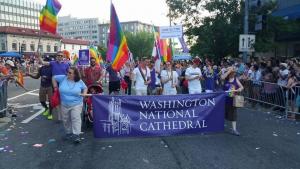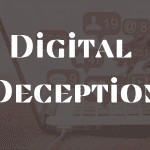Fair warning to readers, I’m going to break my normal restriction on length for this first post because I have a story that is important for our Party to hear again. Throughout history, communities have created identities and passed on understanding through stories. This isn’t the full story, but it contains important truths that need to be retold because they have been forgotten by many in our Party.
Seven years ago this week, I was praying about whether I should leave my job on the Hill to help start the first Democratic consulting firm focused on faith outreach. A few weeks earlier, John Kerry’s former faith director, Mara Vanderslice, had approached me about joining her in this new venture, and it was time for both of us to decide if we were going to take a leap of faith together.
To set the stage, Democrats were reeling from the Kerry loss and stung by the fact that in 2004, being a weekly church attendence was just as good an indicator someone would vote for Bush as being a registered Republican. Democratic leaders saw a problem at the same time as a new crop of Democratic candidates were emerging who had a strong and authentic faith that truly shaped who they were. They wanted to talk about their faith and wanted to engage their fellow believers. The catch was that Democrats didn’t have much of a clue how to go about doing it in a campaign context. Whether by blind luck or Providence, Mara and I launched Common Good Strategies in that moment when Democrats were seeking to reengage with average voters and get back to articulating the values that define who we are as Democrats.
Mara and I had a lot of ideas but two core founding principles. First, we knew this work would not succeed unless it was done authentically and from a place of religious humility. There was not a one-size-fits-all approach to what we did. We committed early that we would only work for candidates who had an authentic desire to engage the faith community. And when we talked about faith, it was in the context of how faith informed our values rather than trying to tell people what God wanted or how Christians should vote.
And second, we believed it was possible to align what was right with what worked politically. We rejected the notion that faith in politics required some sort of Faustian bargain, which meant we also rejected the idea that the only way to win was to sell out. We recognized the need to respect the rules and limitations of politics, but we believed that not only was it possible to align what was right with what worked politically but that doing so was the most effective way to bring about lasting and meaningful change.
And so with those stars to guide us and a lot of enthusiasm, I left my job on the Hill working for a mentor in Democratic faith and politics, Rep. David Price, and joined Mara in the trenches of Democratic communications and outreach work. As I said, we hit the historical sweet spot and before we knew it, we were in senior positions on five Senate and Governor’s races, consulting for the Democratic Senate Campaign Committee, and working for three state parties and a number of House candidates.
It was an incredible, scary, wonderful experience…and we learned a lot. We developed the “listening meeting” model for pastor engagement, which was pretty radical at the time. Rather than bringing politicians in to talk at congregations and pastors, we asked pastors to host small roundtable meetings where we and our candidates asked them questions and mostly listened to what the pastors had to say. It created a completely different dynamic and opened new doors that would have been impossible under the more traditional bi-directional townhall or short (and in my view, inappropriate) address by the candidate to a congregation during worship.
The listening meetings were a huge success. In 2006, we met with over 300 pastors and priests in small group (less than 10-people) listening meetings. We lost count of the number of pastors who said they and their congregations were always hearing from Republicans but this was the first time a Democrat had ever reached out to them. We created massive pastor and lay-leader networks from scratch in OH, MI, PA, KS, and NC. And we developed trusting and real relationships–with perhaps the best example being when a group of white, pro-life, traditional marriage pastors agreed to draft the preamble to the Michigan Democratic Party platform, which is still in use today.
In Pennsylvania, our lists enabled us to send a mailing to every Catholic priest in the state less than 24-hours after Catholic parish parking lots were fliered by Republicans during Mass. In response to our letter asking that priests ensure worship wasn’t used by anonymous groups to bear false witness in pursuit of political power, most priests made an announcement the following Sunday (two days before the election) condemning the fliers and those behind them. A number of priests even went as far to share Bob Casey’s faith and values brochure with their congregation the Sunday before the election to ensure their parishioners got to hear from both sides.
As successful as the outreach programs were in ’06, the reason these programs worked so well was that our campaigns did not view faith as a constituent group. Our work was integrated into the communication and macro-strategy aspects of the campaigns as well.
Our candidates ran ads on Christian radio specifically tailored to connect with those audiences. They spoke at faith gatherings and Christian colleges. They included faith media in their press releases. And in all of that, the candidates and campaigns became much more comfortable and adept at articulating their values. They sounded the same when they spoke to faith audiences and the general public. And what they said resonated with both religious and secular voters because our candidates weren’t citing chapter and verse but clearly articulating their values.
So often Democrats focus on WHAT we’ll do and WHAT policies we support. Our candidates spent most of their time talking about WHY they supported those policies and WHY they were running. And voters care much more about the WHY than the WHAT.
At the same time we were working on the campaign side, there was a huge growth of progressive faith non-profits and other efforts, like FaithfulDemocrats.com (which launched in 2006), that all played a key role in helping change the national discourse and till the soil that allowed the Democratic faith outreach to flourish.
The results of all of these new strategies and converging efforts were pretty amazing. When the votes were counted after the ‘06 election, the candidates we’d worked with did a whopping 20 points better with white protestants than Democrats on average, and in a year where Democrats made major national gains with Catholics (in large part because of the national attention many of our Catholic candidates received), our candidates still did 7 points better with Catholics than the average Democrat.
And that got people’s attention! The state programs we’d started in ‘06 were expanded, and both the Clinton and Obama campaigns made faith and values a central part of their strategy, dedicating resources and senior staff to these programs. In ’08, Common Good Strategies was subsumed by the Eleison Group, which soon became the lead consultant for the DCCC’s “Red to Blue” program, working with over 30 Democratic candidates running in Republican districts. Again, Democrats achieved huge success. Obama made major gains with Catholics and evangelicals, and states that implemented robust faith outreach and messaging programs saw even greater pick-ups.
If this was a fairy tale, I’d stop there with a “And they all lived happily ever after.” But history is different from stories in that it continues. Key characters move on into other stories, and new ones are added. Challenges change. And even the best intentioned efforts and people will make mistakes at some point. This story is no different. For various reasons, Democrats stopped doing the things on campaigns that had worked so well for them and put them in power. Most of the faith programs were shuttered, and investments in communication, staff, and political outreach disappeared in ’09-’10.
The result is that we now find ourselves in much of the same place we did in 2005. We face major challenges and deficits in how voters view Democrats when it comes to faith. The majority don’t even believe our President is a Christian. The good news is that the reason has much less with what Democrats have done, and definitely isn’t a result of what we believe, and is mostly a result of what we haven’t done: we’ve stopped engaging with and communicating to America’s faithful.
But perhaps the best news is that unlike 2005, we know what works and have a number of resources we did not then. We have lists of tens of millions of evangelical and Catholic voters in swing states. We have lists of all the Christian radio stations, relationships with key faith leaders, and an underfunded but much more robust progressive faith non-profit sector. We have a wealth of experience and very good people in small faith desks at the DNC and Obama campaign.
The night after Kerry’s loss, I wrote a memo that I turned into my first post on FaithfulDemocrats.com. For better or worse, it is a message that Democrats need to relearn. We have to actively engage faith and values voters if we’re going to win back the governing majorities we need to move this country forward. To do so, we should not seek to be the Religious Left or fear that engaging in this work will require us to twist faith in the same way the other side often does. Democrats are the Party of the Second Great Commandment. Our policies are about love of neighbor. But if we want to get credit for those policies and win the trust of voters to enact them, we can’t be seen as being against the First and greatest commandment: Loving God.
Those were the words I used when I was part of the original launch of FaithfulDemocrats in ’06, and they are good ones to use as FaithfulDemocrats starts this new phase of its existence with Patheos. I never could have imagined all the great things ahead when we started this work six years ago, and I can’t wait to see what’s next as we start again now.


